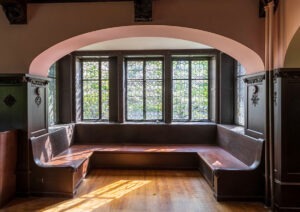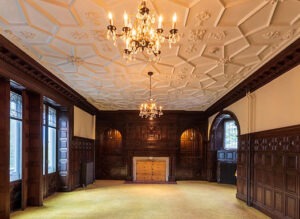A Chestnut Hill mansion gets a renewed life.

Philadelphia has often been extremely hot in the summer, especially back in 1857. To escape the heat and pollution of the city, merchant William Henry Trotter built a 10,000-square-foot summer cottage on Germantown Avenue in then-rural Chestnut Hill.
In 1896, the cottage was expanded significantly into a 17,000-square-foot mansion for the family of Alfred Harrison, who made his fortune in the sugar refining business. The expansion was designed by renowned architects Cope & Stewardson, who designed buildings for Princeton University and the University of Pennsylvania. After the Great Depression, maintaining the large mansion became too costly for the family, and, in the 1930s or 1940s, the Sisters of St. Joseph took ownership of the property, converting it into a convent.
For decades, the convent served the Sisters of St. Joseph and other religious orders. However, as the number of nuns declined in recent years, the sisters could no longer afford to maintain the aging building and grounds and decided to put the Chestnut Hill convent up for sale.
Neighborhood involvement to rescue the convent
When the local neighbors heard the convent was up for sale, they contacted us to do a feasibility study to suggest potential uses for the property that would preserve the historic mansion and grounds. They wanted to prevent a developer from demolishing the building to construct multiple houses on the site. Imagine a historic landmark being replaced by standard suburbia.
Realizing the purchase and restoration of the convent would be too costly for the neighbors, the sale never went through.
Woodmere Art Museum saves the day
 Luckily, the Woodmere Art Museum learned of the sale and acquired the Chestnut Hill convent. Being only two blocks from the museum’s current location, the convent was the perfect site to expand the gallery space to properly display its renowned collection of 20th and 21st-century art from Delaware Valley artists.
Luckily, the Woodmere Art Museum learned of the sale and acquired the Chestnut Hill convent. Being only two blocks from the museum’s current location, the convent was the perfect site to expand the gallery space to properly display its renowned collection of 20th and 21st-century art from Delaware Valley artists.
The owners of the Woodmere Art Museum had been working with New York architect Matthew Baird for 10 years on plans to improve their existing buildings and grounds, so they contacted Baird to renovate the convent and design additions to the structure.
With approximately 80-90% of the museum’s collection in storage, the additional gallery space was essential to the owners.
Krieger & Associates Architects plays an important role
With Baird based out of NY, the Woodmere Art Museum owners wanted local architects to assist with the project. We were hired to obtain the necessary zoning approvals and variances for the renovations, a lengthy process with numerous community meetings required to gain neighborhood input. Shepherding the project through the zoning process, assisting in the design and documentation phases with drawing reviews, and obtaining additional building code variances required for the historic structure—our team assumed all of these responsibilities.
Now that the construction of the renovations and additions is slated to begin, we’ll be undertaking the primary role of construction administration, overseeing that the work is completed according to the approved plans.
The future of the Woodmere Art Museum
With the new museum space exhibits like the one featuring the works of Barbara Bullock, an African American artist from Germantown, will finally gain national recognition. She paints in various styles, including realism, expressionism, and abstraction, with many of her pieces depicting everyday life in the African American community. Her incredible artistic talents address social justice issues and make significant contributions to capture the black experience over many decades.
The Woodmere Art Museum project is a massive win for Chestnut Hill and Woodmere, attracting visitors from across the region, the country, and even internationally. Thanks to the steadfast work of our design team, the mansion lives on – trailblazing a continuously creative history from invigorating industrialism to refreshed faith to admirable artistry that spans across time and culture.